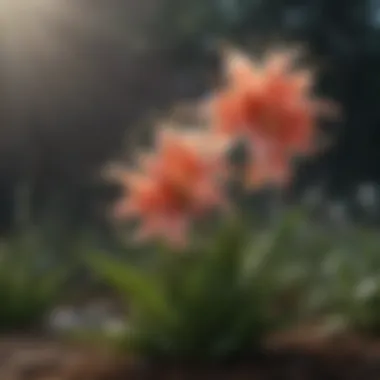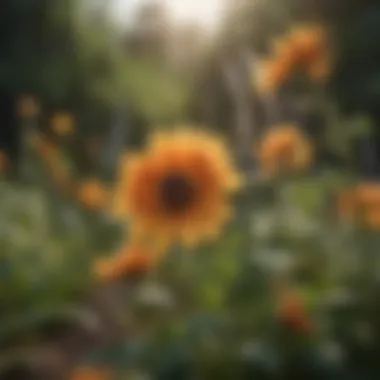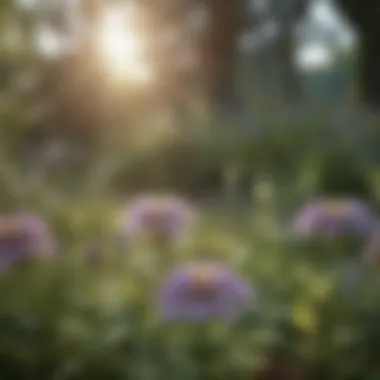Discover the Most Exquisite Flowering Perennials for Partial Sun Gardens


Ultimate Guide to Flowering Perennials for Partial Sun
This comprehensive guide delves into a diverse selection of flowering perennials that thrive in partial sun conditions, catering to gardening enthusiasts seeking to elevate their outdoor spaces. Offering valuable insights and recommendations, this guide is a treasure trove for those aiming to create stunning gardens blooming with long-lasting floral beauty.
Importance of Partial Sun Conditions in Plant Growth
Exploring the significance of partial sun conditions on the growth and blooming patterns of flowering perennials sets the foundation for understanding the plants' requirements. The amount of sunlight directly impacts the plants' photosynthesis process, influencing their overall health and vigor. By grasping this crucial aspect, gardeners can strategically plan and cultivate a thriving garden ecosystem.
Key Factors to Consider Before Planting
Before diving into the world of flowering perennials suitable for partial sun, it is essential to consider factors such as soil composition, moisture levels, and climate suitability. Understanding the specific needs of each plant species ensures optimal growth and blooming, creating a harmonious and visually appealing garden landscape.
Notable Flowering Perennials for Partial Sun
- Coneflowers (Echinacea): Known for their daisy-like appearance and vibrant hues ranging from pink to purple, coneflowers add a splash of color to any garden. These hardy perennials are drought-tolerant and attract pollinators, making them a versatile choice for partial sun conditions.
- Black-eyed Susans (Rudbeckia hirta): With their iconic dark center and golden petals, black-eyed susans are a favorite among gardeners. Thriving in partial sun environments, these cheerful blooms bloom throughout the summer, enhancing the garden's visual appeal.
- Daylilies (Hemerocallis): Offering a wide array of colors and shapes, daylilies are a low-maintenance perennial perfect for partial sun settings. Their trumpet-shaped blooms last only a day but are produced in abundance, creating a stunning display.
Cultivating a Flourishing Garden Ecosystem
Creating a flourishing garden ecosystem involves more than just selecting the right plants. Attention to detail in terms of watering schedules, fertilization techniques, and pest control is vital for sustaining the health and vibrancy of flowering perennials. By implementing a holistic approach to garden care, enthusiasts can ensure their outdoor spaces remain a breathtaking sanctuary of natural beauty.
Harnessing the Beauty of Flora
Incorporating flowering perennials into a partial sun garden transforms outdoor spaces into vibrant havens of color and life. The delicate balance between sunlight exposure and plant care culminates in a visually stunning oasis that delights the senses and nourishes the soul, making it a dynamic and rewarding journey for gardening enthusiasts.
Introduction
In the realm of gardening, the allure of flowering perennials for partial sun conditions cannot be overstated. These enduring beauties bring forth a wealth of colors and textures, infusing outdoor spaces with a touch of elegance and charm. For garden enthusiasts seeking to adorn their landscapes with blooms that withstand varying degrees of sunlight, understanding the world of flowering perennials holds immense value. This guide delves into the intricacies of selecting, planting, and caring for these perennial treasures, offering a gateway to a realm of timeless floral beauty.
Understanding Flowering Perennials
Why Choose Flowering Perennials?
The decision to opt for flowering perennials is rooted in their exceptional longevity and resilience. Unlike annuals that require replanting every year, perennials grace your garden with their presence year after year, forming a foundation of botanical continuity. Their ability to endure the changing seasons and still produce luscious blooms makes them a staple for any garden enthusiast looking for sustainable floral options. The unique trait of returning each spring, often with more vigor, showcases why flowering perennials stand out as a dependable and admirable choice.


Benefits of Growing Perennials
The benefits of cultivating perennials extend beyond their perennial nature. These plants often establish deep root systems, aiding in soil erosion prevention and overall soil health. Additionally, their repeated blooming cycles contribute to a constant source of nectar for pollinators, supporting biodiversity in your outdoor space. The capacity of perennials to adapt to their environment and thrive with minimal maintenance underscores their value in any garden setting.
Factors to Consider in Partial Sun Conditions
When venturing into partial sun gardening, considering the specific needs of flowering perennials is crucial. Understanding the light requirements of each plant species, along with factors like soil drainage and watering schedules, paves the way for a successful garden. Choosing perennials that can harness the available sunlight efficiently while enduring occasional shade demands a thoughtful selection process. Balancing the varying needs of different species within the realm of partial sun conditions ensures a harmonious and flourishing garden environment.
Popular Flowering Perennials
In the realm of gardening, the topic of popular flowering perennials holds immense significance as it guides enthusiasts in selecting plant varieties that can thrive in partial sun conditions. Flowering perennials offer a delightful array of colorful blooms and unique foliage, elevating outdoor spaces with their enduring beauty. When considering popular flowering perennials for partial sun, it is essential to take into account their adaptability to varying light levels and their resilience in less-than-ideal sun exposure scenarios.
Sun-Loving Varieties
Lavender
Lavender, with its delicate purple blooms and distinct fragrance, plays a vital role in the realm of popular flowering perennials. This versatile plant is renowned for its calming scent and medicinal properties, making it a sought-after choice for gardens aiming to achieve both aesthetic appeal and functionality. Lavender's drought-resistant nature and ability to attract pollinators make it a beneficial addition to gardens with partial sun conditions.
Black-Eyed Susan
Black-Eyed Susan, characterized by its bright yellow petals and dark center, contributes significantly to the popularity of flowering perennials for partial sun settings. This resilient plant thrives in various soil conditions and requires minimal maintenance, making it ideal for gardeners seeking a low-effort yet visually striking addition to their outdoor spaces. Black-Eyed Susan's ability to attract butterflies and bees enhances its desirability for pollinator-friendly gardens.
Blanket Flower
Blanket Flower, known for its vibrant red and yellow daisy-like blooms, is a standout choice among popular flowering perennials for partial sun areas. This hardy plant tolerates heat and is relatively drought-resistant, making it a practical option for gardens with intermittent sun exposure. Blanket Flower's long blooming period and attractiveness to hummingbirds make it a favored selection for adding dynamic color to garden landscapes.
Shade-Tolerant Options
Astilbe
With its feathery plumes of flowers in shades of pink, red, and white, Astilbe brings a touch of elegance to shade-tolerant gardens with partial sun. This resilient plant thrives in moist soil and is prized for its ability to add texture and height to garden beds and borders. Astilbe's tolerance for shade and preference for consistent moisture levels make it an ideal choice for creating visually appealing arrangements in areas with limited sunlight.
Bleeding Heart


Bleeding Heart, characterized by its heart-shaped blooms in shades of pink and white, lends a sense of whimsy to shade-tolerant gardens exposed to partial sun. This delicate yet hardy plant is favored for its graceful arching stems and romantic appearance, adding a touch of nostalgia to garden settings. Bleeding Heart's preference for cool, shaded locations and ability to attract bees and butterflies make it a charming option for enhancing the visual appeal of partially sunlit areas.
Foamflower
Foamflower, named for its frothy clusters of delicate flowers, is a sought-after option among shade-tolerant plants suitable for partial sun conditions. This versatile perennial thrives in well-draining soil and is valued for its ornamental foliage and intricate blooms. Foamflower's ability to spread and form dense mats of greenery makes it an excellent choice for ground cover in shaded garden areas, where it adds a lush and vibrant touch.
Versatile Choices for Partial Sun
Coneflower
Coneflower, with its distinctive spiky orange or purple central cones surrounded by colorful petals, is a versatile option for gardens exposed to partial sun. This drought-tolerant plant attracts butterflies and bees while adding a pop of color to garden beds. Coneflower's adaptability to different soil types and resilience in fluctuating light conditions make it a reliable choice for enhancing the visual appeal of outdoor spaces with partial sun exposure.
Coreopsis
Coreopsis, featuring cheerful yellow or red daisy-like blooms, is a versatile perennial celebrated for its ability to thrive in various light conditions, including partial sun. This low-maintenance plant is valued for its long blooming season and attractiveness to beneficial insects like ladybugs and lacewings. Coreopsis' adaptability to different soil types and climates makes it a popular choice for gardeners seeking to create vibrant, dynamic landscapes in partially sunlit areas.
Salvia
Salvia, known for its spiky blooms in shades of blue, purple, or red, is a versatile choice for gardens with partial sun exposure. This resilient perennial is prized for its drought tolerance and ability to attract hummingbirds and butterflies, adding movement and life to garden settings. Salvia's aromatic foliage and long-lasting flowers make it a desirable option for enhancing the beauty and biodiversity of outdoor spaces benefiting from partial sun.
Design Tips for Partial Sun Gardens
Design tips play a crucial role in enhancing the beauty and functionality of partial sun gardens. In this comprehensive guide to flowering perennials, understanding how to design your garden for partial sun conditions is essential. Creating a harmonious and visually appealing landscape involves considering various elements, from plant placement to color schemes. By implementing effective design tips, gardeners can maximize the potential of their outdoor spaces, resulting in stunning displays of natural beauty.
Creating a Balanced Landscape
Utilizing Height Variation
When discussing the topic of utilizing height variation in garden design, it's important to emphasize how this element contributes to the overall aesthetic and practicality of the landscape. By strategically placing plants of different heights, gardeners can create depth and visual interest in their gardens. The key characteristic of utilizing height variation lies in its ability to add dimension to the planting beds, making them more dynamic and engaging. This technique is a popular choice for this article because it allows for a more layered and textured look, enhancing the overall appeal of partial sun gardens. One unique feature of utilizing height variation is its versatility, as it caters to a wide range of flowering perennials, giving gardeners ample opportunities for creative expression and customization. While there may be some challenges in maintaining the balance of tall and short plants, the advantages far outweigh the disadvantages, as the visual impact of varied heights is unmatched.
Color Coordination Techniques
Another essential aspect of designing partial sun gardens is employing effective color coordination techniques. The careful selection of plant colors can significantly impact the overall look and feel of the garden. Highlighting the key characteristic of color coordination techniques involves understanding how different hues can complement or contrast with each other to create visually appealing displays. This technique is a beneficial choice for this article as it allows gardeners to create cohesive and harmonious garden compositions, evoking specific moods or themes. One unique feature of color coordination techniques is their ability to guide the viewer's eye and create focal points within the garden, enhancing its visual flow and cohesion. While there may be some challenges in finding the right color combinations, the advantages of using color to enhance garden aesthetics are undeniable, making it a crucial skill for any gardening enthusiast looking to elevate their outdoor spaces.


Maintenance and Care
Maintenance and Care are pivotal aspects in the realm of gardening, particularly when focusing on flowering perennials suited for partial sun conditions. Effectively managing maintenance and care routines ensures the longevity and vibrancy of the garden. For enthusiasts seeking to cultivate a visually appealing and sustainable outdoor space, understanding the intricacies of watering and soil requirements is essential. Proper maintenance and care not only nurture the plants but also contribute to the overall aesthetics of the garden, creating an inviting and harmonious environment for both humans and wildlife.
Watering and Soil Requirements
Optimal Watering Practices
Optimal Watering Practices play a crucial role in maintaining the health and vitality of flowering perennials in partial sun. By adhering to these practices, gardeners can ensure that the plants receive adequate moisture without risk of over-watering. Consistency in watering schedules, adjusting irrigation based on seasonal variations, and monitoring soil moisture levels are key components of optimal watering practices. This method helps prevent issues such as root rot and dehydration, promoting robust growth and blooming cycles. The intrinsic value of optimal watering practices lies in their ability to sustain plant health and optimize their resilience to environmental stressors, making them indispensable in the care regimen for flowering perennials in partial sun.
Soil Composition Guidelines
Soil Composition Guidelines are fundamental aspects that significantly impact the growth and development of flowering perennials in partial sun conditions. The composition of the soil directly influences nutrient absorption, water retention, and root aeration, thereby affecting the overall health of the plants. Implementing appropriate soil composition guidelines involves understanding the specific requirements of each perennial species and tailoring the soil mix accordingly. Factors such as p H levels, organic matter content, and drainage capacity need to be considered when preparing the planting site. By adhering to soil composition guidelines, gardeners can create an optimal growing environment that supports the flourishing of flowering perennials, enhancing their resilience and beauty over time.
Enhancing Visual Appeal:
Enriching the visual allure of a garden through enhancing visual appeal is a pivotal aspect concentrated upon in the context of this extensive guide on flowering perennials for partial sun. Elevating the aesthetic charm of outdoor spaces calls for a meticulous understanding of the interplay between various elements like colors, textures, and foliage structures. By curating a harmonious blend of complementary and contrasting plant varieties, gardeners can create visually captivating landscapes that are not only pleasing to the eye but also ecologically beneficial. The selection and arrangement of flowering perennials play a significant role in transforming a garden into a vibrant tapestry of colors and shapes, enhancing the overall appeal of the outdoor environment.
Companion Planting Suggestions:
Pairing Perennials for Aesthetic Contrast:
Delving into the realm of pairing perennials for aesthetic contrast sheds light on a specific facet crucial to the overarching theme of enhancing visual appeal. This practice involves strategically pairing flowering perennials with contrasting colors, heights, or textures to create visual drama and interest in garden beds. The juxtaposition of bold, vibrant blooms against delicate foliage or combining plants with varying leaf shapes imparts depth and character to the landscape. Pairing perennials for aesthetic contrast not only aesthetically enriches the garden but also fosters biodiversity by creating diverse habitats for beneficial insects and wildlife.
Pollinator-Friendly Plant Combinations:
Exploring the domain of pollinator-friendly plant combinations uncovers another vital element contributing to the enhancement of visual appeal in gardening discourse. By selecting flowering perennials that attract pollinators such as bees, butterflies, and hummingbirds, gardeners can not only embellish their outdoor spaces with vibrant blooms but also support essential ecosystem functions. Pollinator-friendly plant combinations promote biodiversity and ecological resilience in gardens, ensuring the sustainability of floral populations and fostering a healthy environment for pollinating species. Integrating these plant combinations enriches the tapestry of colors while also playing a significant role in conservation efforts, making them a valuable inclusion in the repertoire of gardening practices.
Conclusion
When it comes to the world of flowering perennials in partial sun conditions, the conclusion serves as a vital piece of the horticultural puzzle. Understanding how to curate a garden that flourishes in such specific circumstances involves a keen appreciation of the intricacies involved. It is not merely about planting and forgetting; it is about a meticulous approach to nurturing these plants. The conclusion of this guide wraps up the narrative beautifully, highlighting the key takeaways and emphasizing the importance of implementing the strategies and concepts discussed throughout the article. It ties everything together, providing readers with a solid foundation to embark on their journey towards creating stunning gardens with long-lasting visual appeal.
Achieving Lasting Beauty
Sustainable Practices for Long-Term Garden Success
Diving deeper into the realm of sustainable practices for long-term garden success, we uncover a world where environmental consciousness meets practicality. This aspect of gardening is not just a trend but a fundamental shift towards a more responsible approach to landscaping. Embracing sustainable practices does more than just enhance the aesthetics of a garden; it fosters a harmonious relationship between nature and nurture. The key characteristic of sustainable practices lies in their ability to promote biodiversity and reduce the ecological footprint of gardening endeavors. By adopting these practices, gardeners not only contribute positively to the environment but also create resilient and thriving ecosystems within their own backyard. The unique feature of sustainable practices is their adaptability across different garden types and sizes, making them a versatile and beneficial choice for anyone looking to enhance the vitality of their outdoor space.
Appreciating the Timeless Charm of Flowering Perennials
In the realm of appreciating the timeless charm of flowering perennials, we delve into a realm where beauty transcends fleeting trends and fads. The essence of this aspect lies in the enduring allure of perennial blooms, which stand the test of time and seasons. By appreciating the timeless charm of these plants, gardeners acknowledge the intrinsic value of nature's cycles and the enchanting display of colors and textures that perennials offer throughout the year. The key characteristic of appreciating the timeless charm of flowering perennials lies in acknowledging the quiet yet profound beauty that these plants bring to a garden. They add depth, sophistication, and a sense of continuity to outdoor spaces, elevating them beyond mere visual appeal. The unique feature of this appreciation is its ability to instill a sense of tranquility and connection with nature, making it a favored choice for those who seek to create gardens that invite contemplation and wonder.







